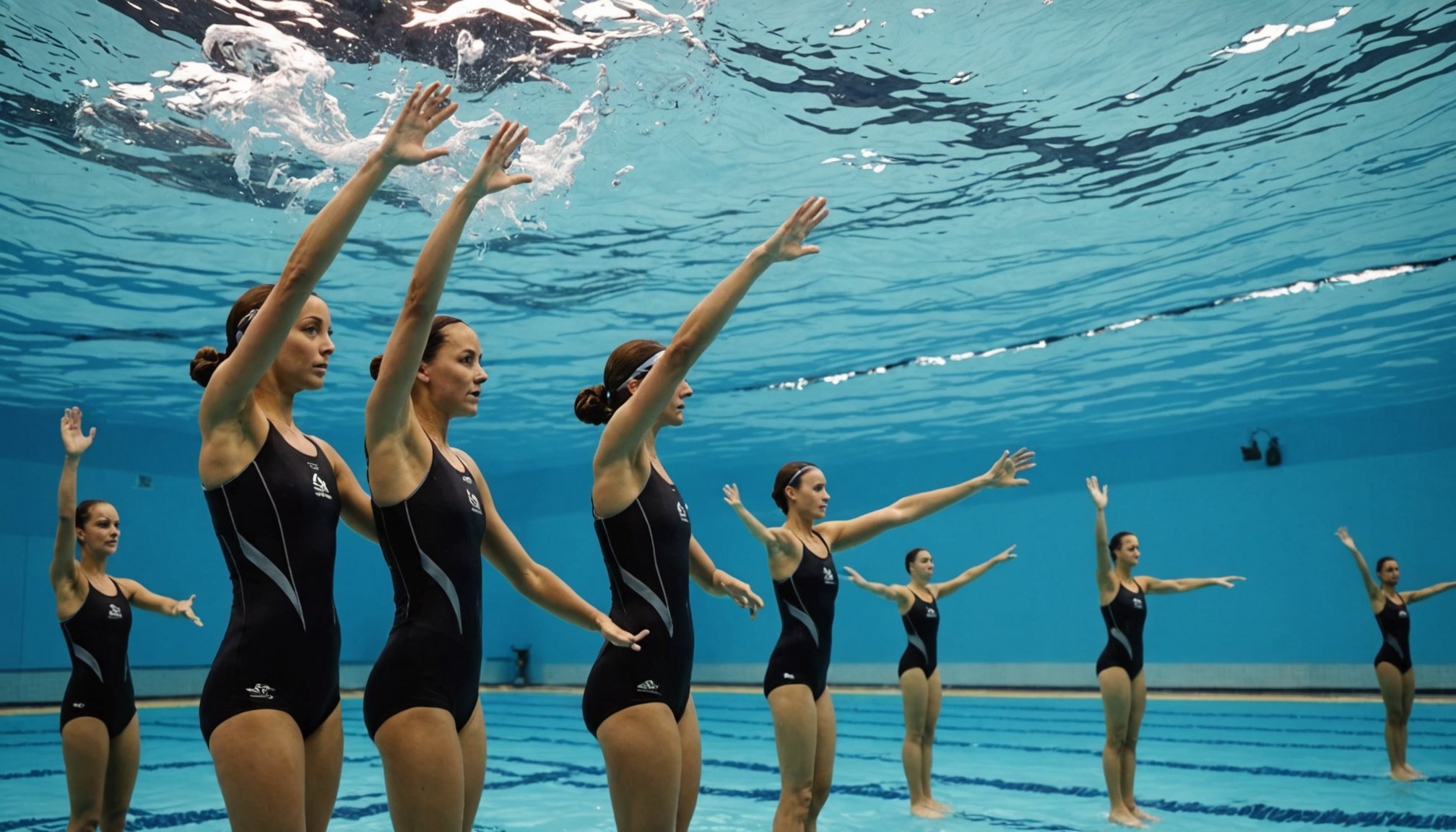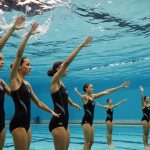Techniques to Foster Communication During Drills
In synchronized swimming, communication is the lifeline holding the team together beneath the surface. Clear communication is pivotal for executing complex routines, especially during underwater drills where verbal cues are limited. Effective communication can be fostered through various techniques aimed at enhancing team dynamics.
One essential technique is the establishment of non-verbal signals. Synchronized swimmers often develop a set of gestures or taps to convey messages during practice. This silent language becomes second nature, allowing swimmers to remain synchronized without verbal distractions.
Also to discover : Secure your gains: key injury prevention techniques for powerlifters
Structured feedback sessions are another powerful method. After each drill, teams should gather to discuss what worked and what didn’t. This open dialogue encourages every member to contribute, reinforcing cooperation and collective problem-solving.
Coaching plays a crucial role in nurturing effective communication. An adept coach facilitates open communication by encouraging swimmers to express individual challenges and perspectives. This dialogue not only improves team unity but also empowers swimmers to adapt to each other’s strengths and weaknesses.
Also to see : Mastering the Game: How Cognitive Training Boosts Decision-Making Skills in Cricket Batsmen
Finally, team dynamics are strengthened by trust-building exercises. These activities foster mutual respect and reliance, forming a foundation where communication flows more freely and becomes a natural habit during both practice and performance.
Importance of Team Unity in Synchronized Swimming
In synchronized swimming, team unity is the cornerstone of achieving seamless and impressive routines. The sport requires an exceptional level of cooperation as each member’s movement must be perfectly timed and aligned with others. This cooperation is critical not only for the execution of routines but also for fostering a harmonious practice environment.
A strong sense of team unity can significantly enhance both performance and creativity. When swimmers function as a cohesive unit, they are more likely to achieve intricate movements effortlessly. Moreover, a united team can often come up with more creative and challenging routines by leveraging diverse strengths and ideas collectively.
Successful synchronized swimming teams often attribute their achievements to a deeply ingrained sense of team unity. For example, the U.S. Synchronised Swimming Team, renowned for their striking performances, consistently emphasizes the value of mutual respect and shared goals. By cultivating a culture of trust and inclusion, teams not only improve their performances but also create an environment where creativity thrives. Team unity in synchronized swimming, therefore, isn’t just about working together; it’s about creating a shared vision that inspires and propels teams beyond ordinary limits.
Overview of Underwater Drills for Team Coordination
Effective coordination is crucial in synchronized swimming, and underwater drills serve as an essential tool to enhance this skill. These drills allow team members to refine their movements and improve their ability to move as one cohesive unit. Practicing underwater provides a unique environment where swimmers learn to rely on non-verbal cues and team intuition, reinforcing their synchronization capabilities.
Underwater training offers a variety of benefits, including increased lung capacity, enhanced endurance, and improved spatial awareness. Different types of underwater drills focus on various aspects of coordination. For instance, drills like the “Mirror Movements” challenge swimmers to mimic their partners precisely, fostering a deeper connection and synchronized movement.
These drills profoundly impact team dynamics by promoting trust and cooperation. As team members engage in shared tasks underwater, they learn to anticipate each other’s movements, resulting in seamless routines. Furthermore, such exercises strengthen both individual skills and collective performance, as swimmers adapt to each other’s styles and rhythms. Through regular practice, these synchronized swimming techniques not only develop coordination but also instil a sense of mutual respect and understanding, crucial elements for any successful team.
Detailed Guide on Innovative Underwater Drills
Engaging in innovative drills is vital for elevating the skill set in synchronized swimming. These drills not only refine movements but also bolster group cohesion.
Drill 1: Mirror Movements
Objective: The Mirror Movements drill enhances precise synchronization between partners. Swimmers face each other and mimic each movement in real-time, emphasizing immediate coordination. This drill hones the ability to anticipate peers’ actions, which is vital during routines.
Instructions:
- Begin by selecting paired swimmers.
- Have swimmers face each other at a short distance.
- Initiate simple movements such as arm waves, gradually increasing complexity.
- Perform the drill for 10-15 minutes, switching leaders to balance practice.
Outcomes: Mastery of this drill enhances intuitive synchronization, fostering a deeper team connection and readiness for complex routines.
Drill 2: The Wave Formation
Objective: Foster team unity by choreographing sequential actions that replicate a wave.
Instructions:
- Line up swimmers horizontally.
- Designate a leader to initiate a movement, spreading like a wave.
- Practice varying speeds and heights to challenge synchronization.
Outcomes: This exercise fortifies coordination, vital for routines requiring cohesive flow and unity.
Drill 3: Group Shapes
Objective: Improve communication by forming specific shapes underwater.
Instructions:
- Visualize a shape and assign roles to swimmers.
- Use hand signals to dictate position adjustments.
- Hold formed shapes for fixed durations to ensure stability.
Outcomes: Strengthens non-verbal cues and enhances team communication.
Assessing the Effectiveness of Underwater Drills
Evaluating the effectiveness of underwater drills is crucial in synchronized swimming. One method is through performance assessments, where coaches observe improvement in synchronization during routines. This involves tracking how well the team executes complex movements and their cohesion during practice.
A practical approach to progress tracking is using feedback loops. These sessions involve swimmers and coaches reviewing performances immediately after drills. Constructive feedback highlights areas for improvement, helping to refine techniques and address individual challenges. Such open dialogues promote continuous development, aligning team strategies with success.
Tools and metrics are essential for measuring improvements. Coaches might use video analyses to pinpoint technical errors and monitor coordination. Additionally, timed tasks can gauge efficiency and response to non-verbal cues. These tools provide tangible data, allowing swimmers to quantify their progress and adjust training regimens accordingly.
Beyond quantitative measures, assessing how drills impact team dynamics is key. An effective drill should foster better cooperation, enhance trust, and improve overall communication. Observing these factors offers insight into the drills’ success, ensuring synchronized teams operate at their peak potential. By combining these evaluation methods, teams can systematically enhance their athletic performance.
Case Studies of Successful Teams Utilizing Underwater Drills
Underwater drills have played a pivotal role in the success of many acclaimed synchronized swimming teams worldwide. These teams attribute a significant part of their accomplishments to rigorous, innovative training techniques that bolster team coordination and synchronization skills.
For instance, the Japanese Synchronized Swimming Team has been noted for their exceptional coordination — a result of meticulous underwater drills tailored to enhance both individual and team competence. Their drills emphasize spatial awareness and quick, precise reactions to non-verbal cues, allowing them to excel in complex routines where every second counts.
Canadian Synchronized Swimmers are another exemplar of success through strategic training. Their approach incorporates unique synchronized swimming techniques like breath work and timed choreography underwater. This not only improves endurance but also fosters a deeper unity among swimmers, resulting in seamless performances during competitions.
Key lessons from these teams include the importance of consistency in practice and the integration of feedback mechanisms to continuously refine their drills. Aspiring teams can adopt these best practices — such as focusing on mutual trust and clear communication — to elevate their performance and achieve their goals with synchronized swimming techniques.











